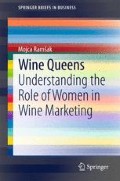Abstract
After the Slovene independence in 1991 winemakers took the example of wine queens from German-speaking countries, because of the lack of any joint promotion of small-scale wine growers and the fright that the wine will be edged out by other, more fashionable alcoholic beverages. Over the years, the title of the wine queen got a certain prestige and the coronations multiplied. This sort of wine marketing rests in the delusion of “old tradition” and royalty. Such comprehending and connecting the beauty pageant ceremonies with royalty and wine, has created the mists of time around the wine queens and increased profits in the wine industry.
Access this chapter
Tax calculation will be finalised at checkout
Purchases are for personal use only
Notes
- 1.
The highest summit in Slovenia (2864 m). The origin of the name Triglav (three-headed) owes its name to its characteristic shape, and to the highest Slavic deity who was supposed to have its throne on the top of the mountain. Triglav is a national symbol and is featured on the national coat of arms and the flag.
- 2.
The only natural island in Slovenia, which is in Lake Bled in Julian Alps, with the pilgrimage church and a 99 steps stairway leading up to the building. It’s the most frequent picturesque depiction of Slovenia.
- 3.
Potica is popular Slovene festive cake, usually with nut filling, followed in popularity by a number of others, such as filling with poppy seed, cottage cheese and tarragon.
- 4.
Traditional Slovene folk art mask, which chases winter away and brings up the spring. It’s the central figure of the annual Kurentovanje festival, during which groups of Kurents (kurenti) dress in sheepskins with cowbells hanging from their belts, furry caps with horns, streamers, feathers and sticks. They go from house to house to scare off evil spirits.
- 5.
In the 20th Autumn Thanking ceremony in the fall of 2012 the twentieth queen was crowned: the Queen of the Queens of Slovene Hills. The title was won by the president of the Society for the Preservation and Development of Heritage that had led the project and prepared the queens to their duties for all the twenty years.
- 6.
Recognised traditional denomination. Prekmurje stew is made of beef, pork, game, potatoes, onion, garlic and paprika. It has its origins in Hungarian goulash (its name is taken from the clay-pot called bograč).
- 7.
The first Honey Queen, who was awarded by Pomurje beekeepers, was crowned in 2009 and the second was crowned in 2012 at the International Fair of Agriculture and Food (AGRA) in Gornja Radgona. Slovene Beekeepers Association didn’t want to join in this project, which was copied by Pomurje beekeepers from Slovene wine growers.
- 8.
So far two Queens of Maribor Wine Growing Region had exceptionally longer mandate: one from 2001 to 2005 and the other from 2005 to 2008.
References
Curk J (2011) Vinska kraljica kot promocijsko orodje destinacije (A wine queen as a promotional tool of a destination). Zaključna projektna naloga (Final project work). Fakulteta za turistične študije Portorož, Turistica, Univerza na Primorskem, Portorož
Kuljaj I (2005) Trte in vina na Slovenskem/Vines and wines in Slovenia. Magnolija, Ljubljana
Pavček T et al (2003) Kronika svečinske vaške trte (The chronicle of the Svečina wine vine). Ljubljana, Svečina (Tipkopis s fotografijami [Typescript with photos])
Ramšak M (2012) Slovenske vinske kraljice: Dokumentarno-vizualna razlaga identitetnih simbolov (Slovene wine queens. Documentary-visual explanation of identity symbols). Časopis za zgodovino in narodopisje 48(2–3):100–133
Ramšak M (2013) Vinske kraljice v risu promocije in lepotnih tekmovanj (Wine queens within the magic circle of promotion and beauty pageants). Glasnik Slovenskega etnološkega društva 53(1–2):79–87
Ramšak M (2014) Wine queens: individual and cultural brand management process. J Ethnography Folklore (Revista de etnografie şi folklore) 1–2:46–63
Šoštarič M (2011) Vinsko krono bo nosila Sandra Vučko (Wine crown will wear Sandra Vučko). Večer 14(11):9
Toplak M (1997) Zahvala jeseni. Juršinci 1993–1997 (Autumn thanking. Juršinci 1993–1997). Juršinci: Občina
Toplak M (2004) Zahvala jeseni. Juršinci 1998–2002 (Autumn thanking. Juršinci 1998–2002). Juršinci
Toplak M (2010) Zahvala jeseni: Juršinci – dežela kraljic 2003–2007 (Autumn thanking. Juršinci—the land of the queens 2003–2007). Društvo za ohranjanje in razvijanje dediščine, Juršinci
Author information
Authors and Affiliations
Corresponding author
Rights and permissions
Copyright information
© 2015 The Author(s)
About this chapter
Cite this chapter
Ramšak, M. (2015). The Lessons from the Slovene Case. In: Wine Queens. SpringerBriefs in Business. Springer, Cham. https://doi.org/10.1007/978-3-319-16661-2_3
Download citation
DOI: https://doi.org/10.1007/978-3-319-16661-2_3
Published:
Publisher Name: Springer, Cham
Print ISBN: 978-3-319-16660-5
Online ISBN: 978-3-319-16661-2
eBook Packages: Business and EconomicsBusiness and Management (R0)

